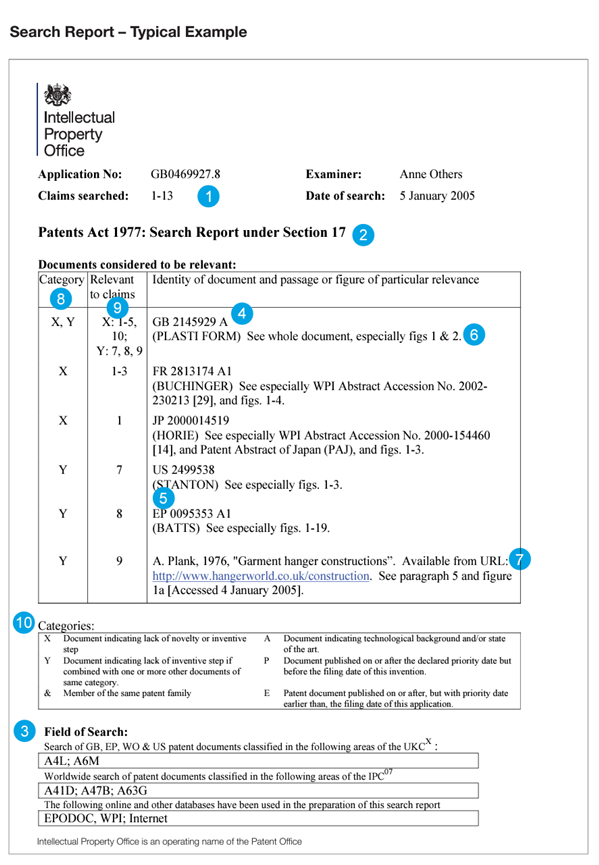During the UK patent application process, after the applicant submits Form 9A, he/she will receive a search report issued by UKIPO. A sample search report is attached on the back. This fact sheet is made to help you understand the report.
What is a search report?
- The search report is the result of the patent examiner's search of your invention to determine whether the invention is novel and inventive. The search is usually based on the technical solutions listed in the claims. If the claims are unclear or cannot fully represent the disclosed invention, it may be based on the invention publicly described in the entire specification. The search results are communicated to the applicant in the form of a search report. If the applicant submits Form 10 to request substantive examination at the same time, then the UKIPO will consider any documents listed in the right column of the report during the substantive examination stage.
What documents will the examiner search?
- Examiners will search for patent documents, non-patent documents, academic journals, newspapers and other public documents published anywhere in the world. Any form of disclosure may be cited to challenge or question the novelty and inventiveness of the applicant's invention, including: patent specifications, Internet articles and technical journals. It may be an English document or just a foreign language document.
How do examiners conduct searches?
- First, all published patent specifications are classified according to the subject matter of the invention. To conduct a search, the examiner will extract the key technical features of the invention claimed by the applicant, and then search the classified materials related to the invention to find evidence that the technical features of the invention may be known or obvious. The examiner usually searches through a database. The database contains published patent data from all over the world and can be searched using classification terms and/or keywords. The examiner may also search within the scope of the Internet, product catalogs and technical journals.
What do categories X, Y, and A mean in a search report?
- The relevance of each document listed in the search report is shown in the "Class" column. Generally speaking, documents identified as class "X" will have the main technical features of the invention (as described in those claims identified in the middle column). Sometimes an invention is considered non-inventive if it combines technical information provided by several documents. Such documents are called class "Y" in the left column. Documents identified as class "A" indicate what has been done before in the technical field of your invention. Class "A" documents will not disclose the invention you are applying for.
Are all claims searched?
- Normally, all claims will be searched. However, if the claims define two or more inventions, the search will be limited to the invention of the first claim. The search may be limited if the claims are unclear or because the claims of the invention are inferred from a large number of documents. In an annex to the search report, the UKIPO will explain why there were no search results.
After receiving the search report, what should the applicant do next?
- Carefully study the documents provided in the search report. Then, based on these documents, the applicant must decide whether to continue with this patent application. If the invention is indeed very different and distinct from what is shown in these cited documents, then the applicant may decide to continue to file a substantive examination request for this patent application and conduct substantive examination (if you have not done so yet). However, if the retrieved comparative documents are very similar to the present invention, then the applicant may decide not to continue the examination. Unless the applicant explicitly requests to withdraw the patent application before it is prepared for publication, this patent application will be published together with a copy of the search report. This is called "publication" and the publication occurs approximately 18 months after the patent application date/priority date (if there is a priority).
The following figure is a sample search report, where:

1: Indicates the number of claims searched
2. Part of the Patent Law related to search
3: Indicates the search scope and provides the search classification number
4: Indicates the patent publication number of the cited document, including the country code of the cited document, such as GB, US, etc.
5. Indicates the applicant/inventor of the cited document
6: Indicates the part of the cited document that is particularly relevant to the claims of the present invention
7: Indicates non-patent literature, such as cited Internet content, etc.
8: Indicates the relevance of the reference to the claim
9: indicates the number of claims that are not novel or inventive based on the information contained in the cited documents
10. Explain what each category means
联系咨询
 | Get exact prices For the country / regionE-mail: mail@yezhimaip.com |

